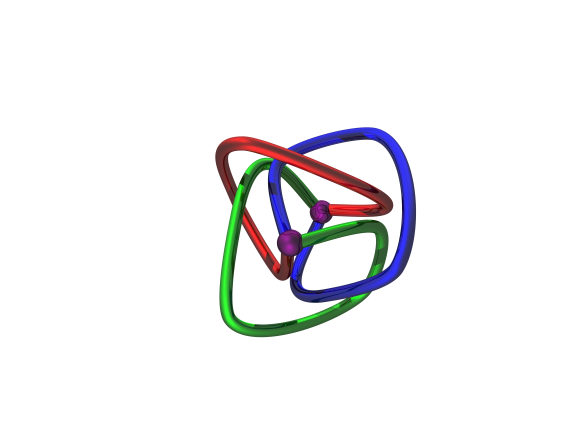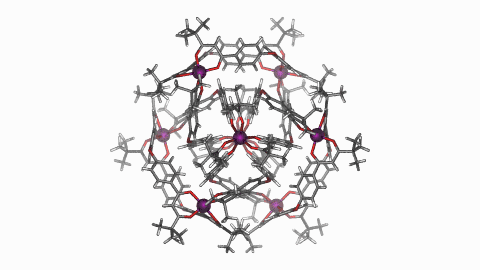When is a knot not a knot? When it's a Ravel!
What does it look like?

A simplified representation of the crystal structure of the Universal 3-Ravel. The purple balls represent the nodes that connect each of the three strands (Red, Green and Blue). Each of the strands passes through loops formed by the other two before joining to the other node. The structure cannot be unravelled without breaking one of the strands. Despite each of the strands being intertwined, because of the presence of three-connecting nodes this structure is topologically not a knot (knots only join strands together with two-connecting nodes).

The crystal structure of the Universal 3-Ravel molecule. The carbon atoms are grey, the oxygen atoms are red, the iron atoms are purple and the hydrogen atoms are white. Images generated using POV-Ray (The Persistence of Vision Ray-Tracer; http://www.povray.org) and compiled with VideoMach.
What is it?
This is the crystal structure of a complex intertwined molecule. It is formed from eight octahedral iron(III) ions and twelve dianionic organic components. The organic ligands have a degree of flexibility incorporated into their design with the two β-diketonato groups that bind to the metal ions bridged by an oxygen group. This means that the ligands are not linear and are able to twist up forming loops and passing through each other – quite like, but not the same as, a knot. In this molecule there are three loops, each of which passes through the other two and the loops cannot be "undone" without breaking a strand.
The topology that results is called a universal 3-ravel. This molecule is the first (and currently only) synthetic chemical example of a Universal 3-Ravel. Ravels are topologically different from knot because they have points ("nodes") where more than two different strands can be joined together. In the universal 3-ravel the strands are joined together with two three-connecting nodes. In a 4-ravel the strands would be joined at four-connecting nodes, etc. Just like in knots, ravels can be classified by the number of times that the strands cross each other. There are an infinite number of potential ravel topologies, which is an area of study in mathematics. Unlike the study of knots, the study of ravels is a very new field and they were only defined as a new topology in 2008 (T. Castle, M. E. Evans and S. T. Hyde, New J. Chem., 2008, 32, 1484-1492).
While molecules like this don't have a specific use yet, the challenges associated with making them teach chemists valuable lessons about making ever increasingly complex molecules. The presences of complex topologies in molecules may eventually lead to new properties in materials like plastics.
Where did it come from?
While the organic parts of this molecule were relatively simple to make, the Universal 3-Ravel structure was a challenge. It took three months of slow diffusion to grow crystals of this material and it didn't want to be rushed! Attempts to speed up the crystallisation resulted in the formation of a much more simple triple helicate structure made of only five components rather than the 20 components in the ravel. The preparation and crystal structure were reported in: "Metallosupramolecular self-assembly of a universal 3-ravel", F. Li, J. K. Clegg, L. F. Lindoy, R. B. Macquart and G. V. Meehan, Nat. Commun., 2011: 205, doi:10.1038/ncomms1208; the CIF is available from: http://www.nature.com/ncomms/journal/v2/n2/extref/ncomms1208-s2.txt and the CCDC deposition number is 791999.






